8. Tariffs for a new age
We set network tariffs each year to collect the revenue allowance set by the AER. In the current period, we started a journey to improve the fairness of our tariffs to better reflect each customer’s share of network costs. For the 2024-29 period, we want to consult with customers on the need for further tariff changes. Our proposed changes seek to reduce future costs through tariff structures that encourage customers to shift consumption and solar exports to periods when the network has spare capacity.
In Chapter Six, we described the process for how the AER places a ceiling on the revenue we can collect for our network services based on expenditure plans and previous investments. To collect the revenue, we set network tariffs based on a customer’s connection, energy and demand for our network services. Importantly, the network tariff is charged to the retailer rather than the customer.
Our network tariffs seek to collect revenue from customers in an equitable way, where customers are allocated their fair share for the costs of network services. The related objective is tariffs that encourage customers to best utilise the capacity of the network for example by shifting demand to off-peak periods. This improves affordability for all customers by improving utilisation, a strategic focus that we outlined in Chapter Three.
The NT NER requires us to develop network tariffs that align with Pricing Principles that relate to economic efficiency. Under the Pricing Principles, we must set tariffs to recover the expected future costs of building new networks. This involves setting a charge that reflects the long run marginal cost (LRMC) of our network services. Any residual costs should be recovered by tariffs that collect revenue from customers in the least distortionary way.
Figure 54 describes the key steps in setting network tariffs.
- Step One is developing tariff classes based on grouping customers into tariff classes and segments. This recognises that it would be administratively difficult to establish a price for each individual customer. The process instead seeks to group customers based on similar characteristics, usage of the network, and meters. For example, we group our customers based on whether they are residential, non-residential or a major energy user. We also develop our groupings based on consumption, and whether the customer connects to our high or low voltage network. Finally, we have separate tariff groupings for smart meter customers.
- Step Two is to collect revenue from these customer groupings in a way that reflects the fair share of their use of the network. This is based on factors such as where customers connect to our network, and how much energy and peak demand is dedicated to the customer group.
- Step Three is to identify the mix of tariff types that should be used to set tariffs. The process is based on developing a mix of efficient price signals that result in customers paying a fair share based on how they use the network. This includes fixed charges, energy consumption, and peak demand charges that may vary based on the time of day or season.
- Step Four is to develop rates for each of these tariff components that result in collecting our annual revenue, based on the optimal allocation of revenue among each of the tariff components.
Limitations of network tariffs in the NT
In our discussions with customers, we have noted that our network tariffs are not passed through to the customer by the retailer, and this limits the ability of our network tariffs to provide a direct price signal to customers. For small customers, the retailer must use the tariffs in the NTG Pricing Order. These tariffs do not have a specific network component, nor are the charging parameters the same. For larger customers, the retailer has the option of directly passing through our network tariff.
Figure 54 – Process for setting network tariffs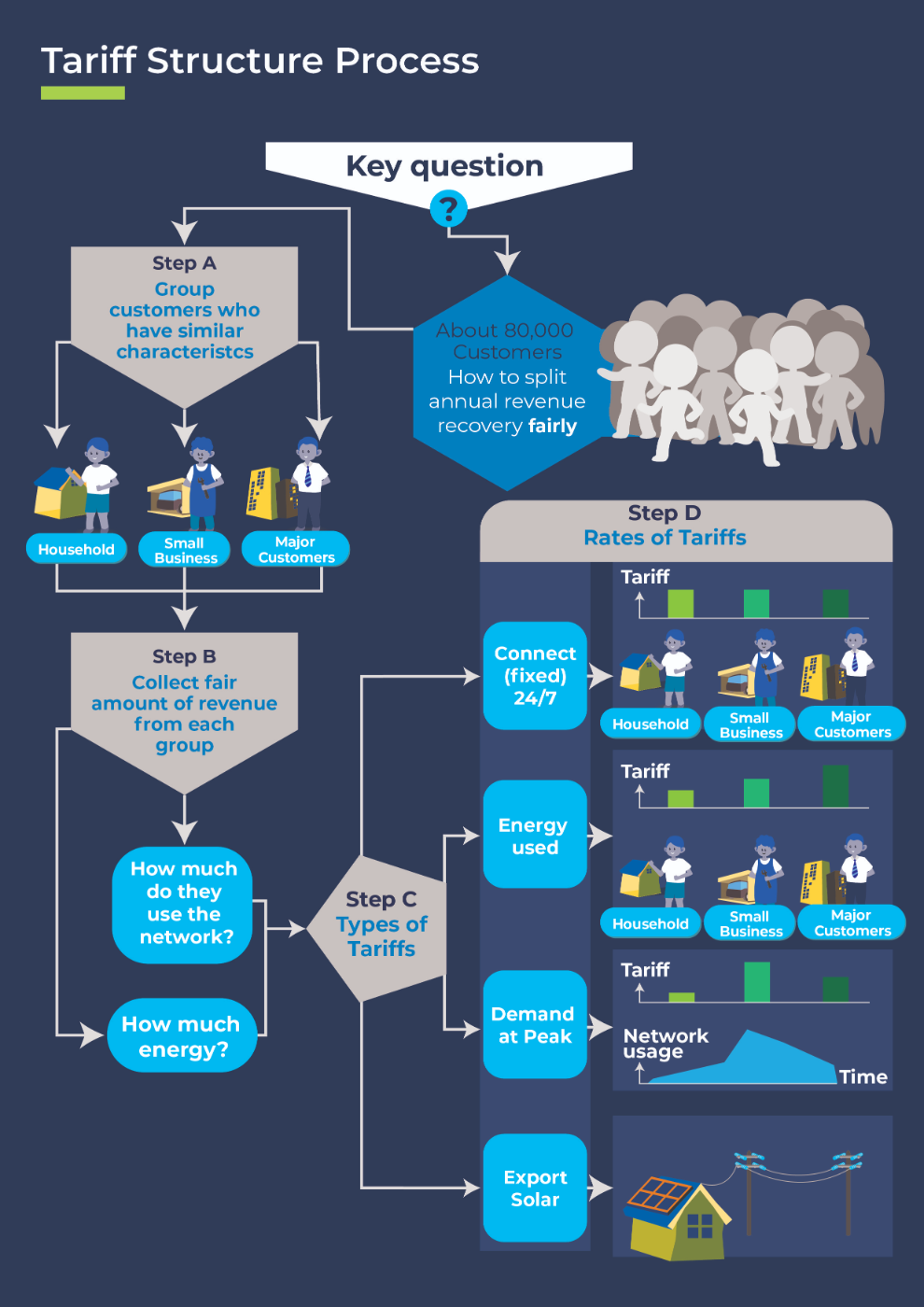
8.1 Network tariffs in the current period
In the 2019-24 period, we made significant changes to our network tariffs. The key driver of change was the application of the national framework for regulation. A further driver of change was stakeholder feedback particularly from the AER on driving more efficient tariffs.
In response, we made four key changes in the 2019- 24 period. Firstly, we simplified our tariff structures to limit the parameters. Secondly, we shifted to peak demand pricing structures rather than rely predominantly on energy consumption charges. Thirdly, we had sought to re-balance revenue between different tariff classes to better align costs of services with revenue collection. Lastly, we sought to implement a power factor correction trial to reduce energy losses.
At the time, our meter fleet was largely accumulation meters. Customers that had this type of meter could not effectively transition to more efficient tariffs. For this reason, we had proposed a progressive rollout of smart meters to ensure that more customers had more efficient tariffs.
Our proposed changes to network tariffs was largely accepted by the AER in the 2019-24 determination. Our customers are currently grouped into seven tariff classes with assignment based on whether the customer is residential or non-residential, the annual energy consumption, the type of meter, and whether they are connected to the high or low voltage network.
There are only three types of charges. The System Access Charge (SAC) is based on the days a customer is connected to the network. The Anytime Charge is based on total energy consumption. The Peak Demand Charge is based on the maximum demand of the customer within in a month in the peak period. The peak period is 12pm to 9pm on weekdays. For smaller customers with smart meters, the peak period is between 1 October and 31 March each year and for larger customers it is all year round. The tariff classes and charges are set out in Table 6 below.
Table 6 - Tariff parameters approved by AER
| Tariff | System Access Charge (SAC) | Anytime kWh (c/kWh) | Peak Demand ($/kVA) |
|---|---|---|---|
| Tariff 1 Residential customers consuming <750MWh with standard accumulation meters | |||
| Tariff 2 Non Residential customers consuming <750MWh with standard accumulation meters | |||
| Tariff 3 LV Smart Meter consuming <750MWh with smart meters | |||
| Tariff 4 Unmetered Supply (for connections without metering such as traffic lights and streetlights) | |||
| Tariff 5 LV>750MWh Customers connected to the LV network consuming >750MWh | |||
| Tariff 6 HV<750MWh Customers connected to the HV network consuming <750 MWh | |||
| Tariff 7 HV>750MWh Customers connected to the HV network consuming >750MWh |
While the AER accepted our network tariff proposal, it requested improvements in our approach. Specifically it noted the need to:
- Establish a more robust approach to energy forecasting, consistent with system demand forecasting approach and needs to consider a number of variables that may impact prices in a 12-month period.
- Investigate and refine our methods for estimating long run marginal cost.
- Further investigate the timing of periods of our peak period window.
- Provide further justification of the need for individually calculated tariffs and the need for a power factor correction tariff.
8.2 Case for more efficient tariffs
In our 2024-29 regulatory proposal, we will publish a Tariff Structure Statement (TSS) that describes any changes we are seeking to make to our current arrangements. The AER will make a determination on whether to approve or seek changes to our TSS.
As noted in Chapter Three, our network is facing rapid global and local changes that will influence our future costs. A key strategic focus for us moving forward is to improve the utilisation of the network by delivering more energy and solar export capacity, while minimising new network investment. We see that network tariffs will play a key role in activating this strategy by providing customers with price incentives to use our network in off-peak periods.
In our consultations with customers, we noted how our future costs could be minimised through tariff reform that better manages when customers use our network.
Managing peak demand in the evening
Peak demand growth across our network has been relatively flat over the last decade. Due to the extreme heat, demand for electricity is highest in the middle of the day in the October to April period.
Over the last five years, we have seen less demand for electricity from our network in these peak periods. This has largely been a result of customers using their own solar panels to energise their homes and businesses. Demand for electricity from our network has shifted to the early evening period when the sun is no longer shining. Figure 55 shows the underlying energy demand compared to demand delivered by the network on the maximum day in the Darwin-Katherine electricity system in 2020-21. Increasing solar will not help curb peak demand over the next 20 years now that peak demand has shifted to the evening.
We are also seeing a significant uplift in customer numbers in the 2024-29 period including major residential and industrial developments. This will accelerate demand for our network services, adding to demand at peak times. Post 2030, we expect an acceleration in electric vehicles in the Northern Territory. Electric vehicles will lead to significant increases in energy required from our network in all areas and will drive an increase in peak demand if customers charge in the evening peak period.
While the network has some capacity to meet growth in peak demand, we anticipate that significant and systematic growth will necessitate a major need for new infrastructure at high cost. In this context, tariffs play a key role in providing signals for customers to use energy outside of peak times. While our current tariffs include a peak charge, there is an opportunity to provide more targeted signals on the cost of network electricity in peak periods relative to times of spare capacity.
Managing solar in the day
Our future network strategy is directed at a hosting solution that helps us more clearly identify opportunities to unlock solar securely without causing network voltage or system inertia issues. However, with a doubling of rooftop solar forecast by 2030, we expect that some exports will need to be ramped down or curtailed. Figure 56 shows the minimum demand day on the Darwin-Katherine electricity system. There is a significant decline in demand for our network electricity between 2017 and 2021 in the middle of the day.
Network tariffs could incentivise customers to use more of their own solar, rather than exporting into the grid during these periods of high export demand. Additional demand in the middle of the day would also help increase load on minimum demand days. Both measures would help us lift constraints on solar exports.
Currently, our demand charge in summer is set from midday onwards, which does not provide the right signal to use more power between midday and 2pm, when solar production is highest. We also do not have any signal for customers to export more in the afternoon when the demand on the network is higher.
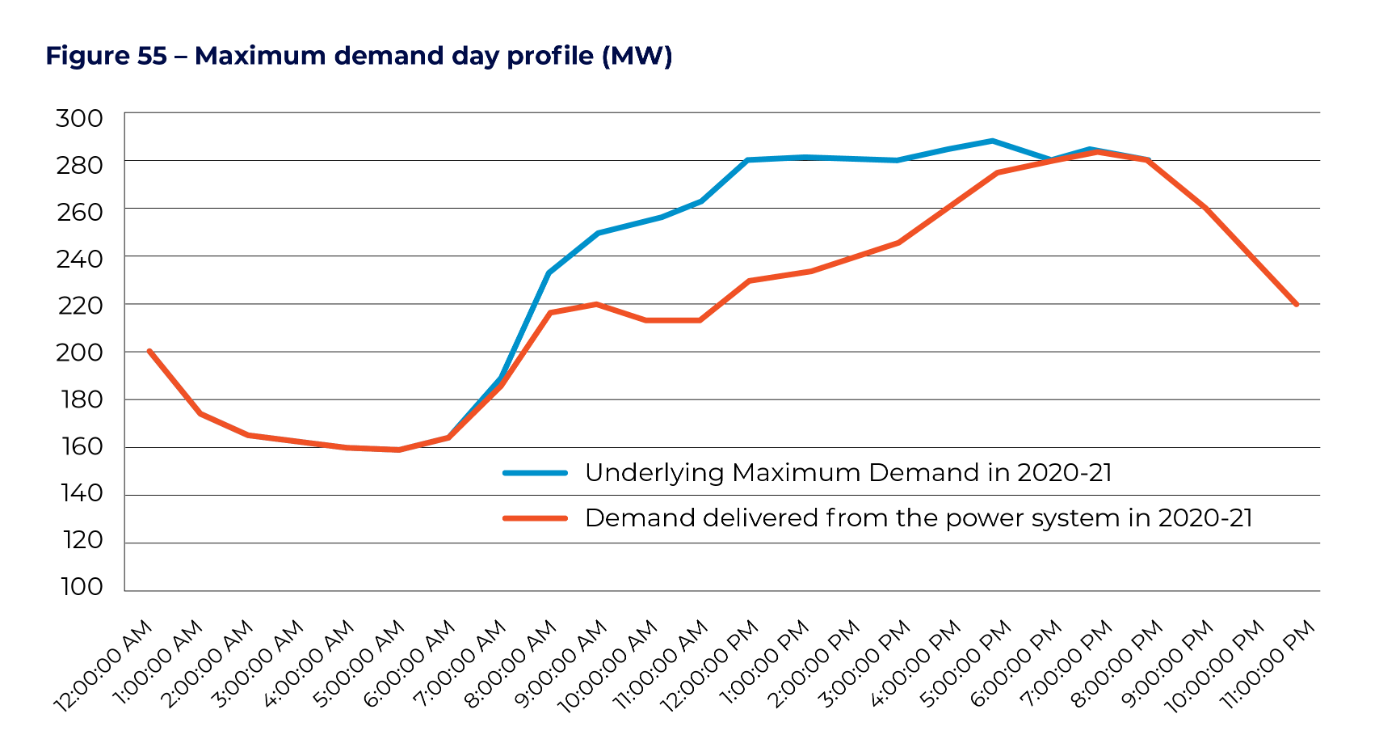
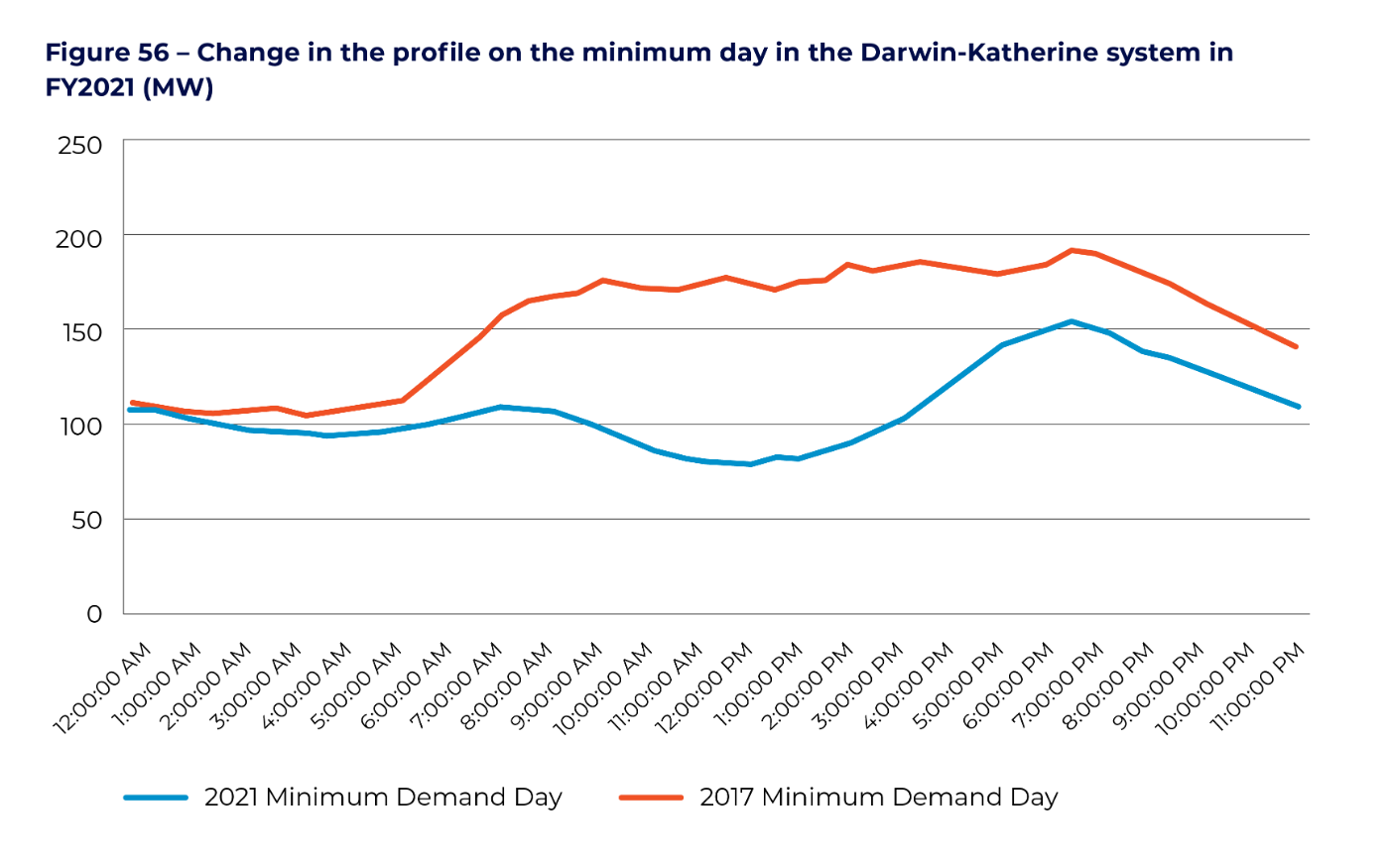
8.3 Strategy and principles for tariff reform
Our strategy has focused on changes in tariff reform that responds to the network impact of rising peak demand in the afternoon/evening periods in summer and solar in the middle of the day. We have been discussing our strategic thinking and options for pace of reform with stakeholders, and this has influenced our position in this Draft Plan.
Principles underlying tariff reform
There are four key principles behind our thinking on efficient tariff reform. Firstly, we see a need to keep our structures simple. This is because we understand that pricing signals need to be clear and understandable. Secondly, we have considered whether changes could lead to unmanageable bill impacts, particularly to our larger customers who are likely to have the network tariff applied directly to them. Thirdly, we have considered equity issues particularly between customers with different meter technology, noting that there should not be a wide gap between customers with similar usage patterns. Fourthly, we considered practical constraints such as billing systems and time to communicate new tariffs to customers and retailers.
There are four key principles behind our thinking on efficient tariff reform. Firstly, we see a need to keep our structures simple. This is because we understand that pricing signals need to be clear and understandable. Secondly, we have considered whether changes could lead to unmanageable bill impacts, particularly to our larger customers who are likely to have the network tariff applied directly to them. Thirdly, we have considered equity issues particularly between customers with different meter technology, noting that there should not be a wide gap between customers with similar usage patterns. Fourthly, we considered practical constraints such as billing systems and time to communicate new tariffs to customers and retailers.
Strategic direction
At a high level, we see that the tariff reform applied in the 2019-24 period provides a solid foundation for further tariff reform. We note that tariff reform is enabled by smart meters, and that the continued rollout of smart meters is integral to implementation in the future.
We consider that the current tariff classes and segments are simple and effective at grouping customers with similar characteristics and use of network services. Our strategy identifies minor changes to separate segments of our existing tariff classes could help strengthen the price signal and also assist with retail competition in the future.
Under changes in the NT NER, we require a new type of tariff for customers that export solar through our network. This is consistent with our need to manage solar in the middle of the day and to meet growing peak demand through stored solar.
A key strategic change is the refinement of time of day pricing. This includes tightening the peak period to align with the time and seasons when our network experiences the highest demand. This includes tightening the peak period to align with the time and season when our network experience the highest demand. We also see the need to provide the right incentives for customers to use more energy in the middle of the day to manage.
Our proposed strategic direction is to place greater emphasis on demand rather than energy charges, particularly for larger customers. This includes adjusting the rates to more reflect the long run marginal cost.
Feedback from stakeholders
We are mindful that our consultation on tariff reform has been relatively limited to discussions with retailers and with the People's Panel in Darwin. We recognise that this is an issue that requires more consultation with customers, retailers and broader stakeholders.
Our consultation on tariff reform has been predominantly with Retailers operating in the Northern Territory. It is retailers who see our network charges and bundle these charges with other costs to separately bill customers. We have also engaged broadly with residential customers on pricing arrangements in the Territory.
Our People's Panel in Darwin noted the limitations of reform given that the tariffs of small customers are set in the NTG Pricing Order and do not align with network tariff structures. However, the Panel wanted Power and Water to develop network prices that made it easier for retailers (and government) to pass better price signals. Most Panel members preferred options for customers to be able to choose from, but also recognised that there was a need for efficient price signals to impact all customers.
In our options we also discussed the pace of reform. Our customers were mindful that changes in tariffs can have an affordability impact on vulnerable customers who cannot change their energy usage patterns, or were not provided with communications. They asked us to think about introducing reform at a slower, incremental rate.
8.4 Proposed changes to Tariffs
In the following sections, we discuss the key changes we are proposing to make in the 2024-29 period.
Step One – Proposed changes to how we group customers
We currently have seven tariff classes, with no further segmentation. We are not proposing any changes to our tariff classes, but we are considering introducing further segmentation to provide a more targeted price signal based on the characteristics of the customer class.
We are planning to separate the existing tariff class for small customers with smart meters (Tariff Class 3) into two segments. Under this plan, customers consuming less than 100MWh will be assigned to Tariff 3a and customers consuming between 100MWh and 750MWh will be assigned to Tariff 3b. This follows retailer feedback on how to encourage and expand retail competition in the future.
In respect of other potential changes, we are examining whether the benefits of an additional tariff segment for our largest customers who may have different characteristics when setting the peak charge. It is also likely that we will also introduce a new class for generation customers including battery operators.
Step Two – Proposed changes on allocation of revenue between customer groups
We are currently analysing whether any changes are required in how we allocate revenue among customers. This issue is also dependent on any changes to our calculation of long run marginal cost and its application in changes to tariffs.
Step Three – Types of tariffs and charges
Under our AER approved TSS, customers in each tariff segment are subject to a range of different components to which a charge is applied. This includes a fixed charge for daily system access, an energy charge, and a demand charge for customers with smart meters. We are proposing to make the following changes subject to further consultation with customers.
- Time of day – energy consumption charge
Currently, we have a single 'anytime' charging parameter for the energy consumption component of tariffs, even if the customer has a smart meter.
We are proposing to apply an energy charge based on the period and time of day when energy is consumed. This would only apply to customers with smart meters as accumulation meters do not provide this level of data. We consider that the change is required to signal to customers when the network is experiencing peak demand in the evening, and when there is ample capacity to meet demand in the middle of the day. The high price period for energy replaces the maximum demand charge for most customers. Figure 57 conceptualises the key change we are proposing to implement.
The periods and rates are described in the next section on charging periods and rates.
- A new export charge
Under the new NT NER Rules, we have an obligation to consider whether rooftop solar customers should pay a charge for using our network to export energy if this leads to higher costs for all customers. As noted in the previous section, our future network strategy is aimed at unlocking household solar through a hosting solution where we can demonstrate a benefit to all customers through lower electricity costs. This recognises that solar is lower cost than other sources of energy in the NT, and that unlocking more solar can lead to improved affordability for all customers.
There will still be periods in a day when our network cannot securely meet the export demand of customers without jeopardising the security and quality of network services, or high costs of new infrastructure.
To ensure fairness for all customers, we are consulting on potential export charges that provide price signals to efficiently manage solar on our network. This includes a tariff charge in periods where our network has difficulty managing exports, and a rebate when the network requires an injection of energy during peak demand times. We consider this provides household customers with the right incentives to export solar when there is capacity on the network, and to use batteries and other technologies to capture excess solar and discharge in the evening peak periods. This is conceptualised in Figure 58.
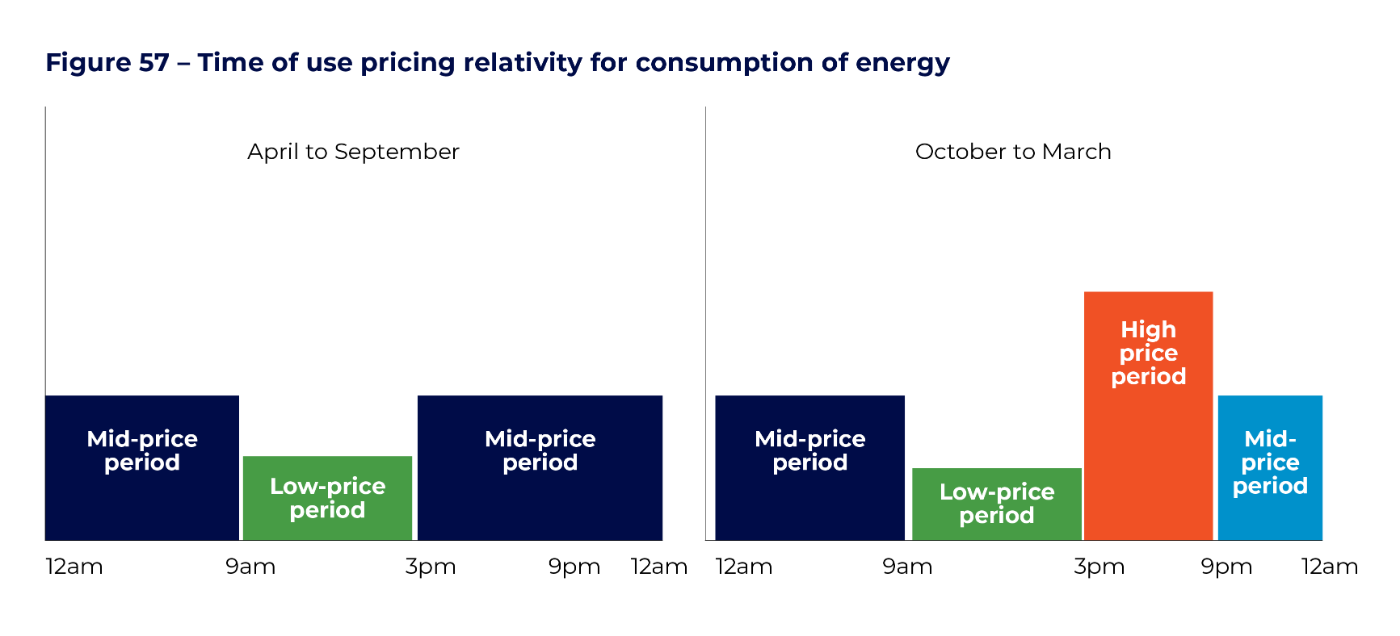
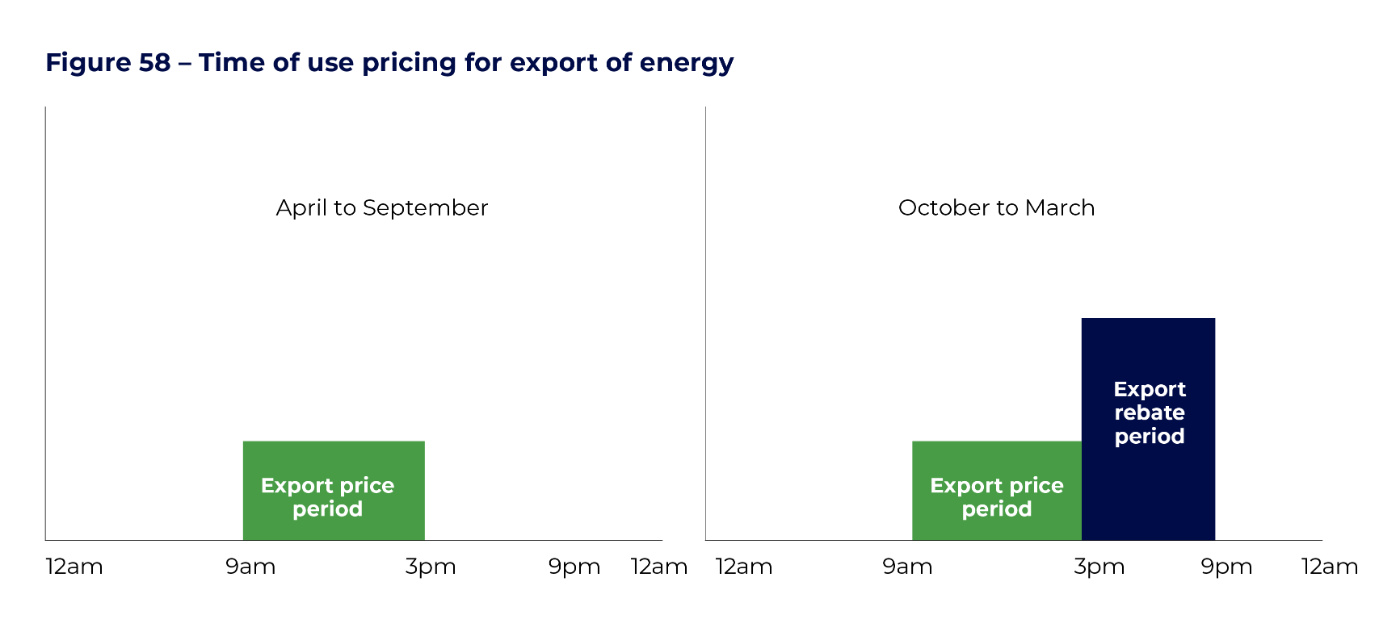
Given the magnitude of the change, we propose to introduce new export tariffs from FY2026 onwards. The time periods where charges and exports would occur are discussed in the next section on charging periods and rates.
Demand charge parameters
We currently apply a demand charge to all customers with a smart meter. For the new segment of smart meter customers consuming less than 100MWh, we are proposing not applying a demand charge and only applying energy consumption charges.
For customers consuming more than 750MWh, we are considering the introduction of a charge reflecting the average of KVA demand in the peak period applied as a daily rate. Residual costs will be recovered by a fixed charge and an off peak monthly demand.
Step Four – Charging periods and rates
Currently, we have a peak period of 12pm to 9pm on weekdays. For larger customers this is all through the year, and for smaller customers it is between October and April.
For smaller customers with smart meters consuming less than 750MWh, we are proposing to narrow the hours of the peak period. This reflects the analysis presented in the last section that shows that our peak demand is shifting to the evening when the network cannot rely on solar to help meet underlying demand. This provides a sharper signal on the drivers of future costs for the network. We have decided not to overly narrow the time period due to the variability of when the peak demand occurs at different locations of our network. As part of this change we also plan to include a greater distinction between off-peak periods. The new periods are:
- Peak congestion (busy) period: From October to March, weekdays between 3pm and 9pm. The long run marginal cost will be allocated to these periods.
- Super off-peak (easy) period: Every day of the year between 9am and 3pm. It is proposed that little or no charges will accrue to customers in this period to encourage consumption to soak up excess rooftop PV.
- Off-peak (light) period: All other periods. Residual costs will be allocated to this period (in addition to the standard access daily fixed charge).
Further analysis of some LV and HV customers is required to determine if all customers will transition to the same peak window, or whether a different segment will be created for some customers reflecting their ability to create a new asset peak due to their size.
We propose to move away from a using a single period maximum (kVA) window to apply LRMC charges. Instead, customers using less than 750 MWh will be charged kWh rates in the peak period. For customers consuming less than 100MWh, residual costs will be recovered via the system availability (daily fixed) charge and kWh rates in the off-peak period. For customers consuming more than 100 MWh and less that 170 MWh there will be the option for a maximum demand (KVA) charge in off-peak periods. However, this is likely to occur during the period.
Table 7 shows the types of charges we intend to apply in the 2024-29 period.
Table 7 - Tariff changes proposed
Network Tariff | Tariff Class | Fixed | Energy Consumption Charge | Energy Demand Charge | Energy demand at peak charge | Export charge | Export Tariff | |||
Fixed ($/day) | Anytime (c/kWh) | High Period (c/kWh) | Mid Period (c/kWh) | Anytime (c/kWh) | Highest recorded demand in month ($/kVA) | Average of all recorded demand in high period in a month ($/kVA) | Export price period (above threshold) | Export rebate period (c/KWh) | ||
Tariff 1 | Residential | Yes | Yes | - | - | - | - | - | - | - |
Tariff 2 | Non- Residential |
Yes |
Yes | - | - | - | - | - | - | - |
Tariff 3a | Res + Com with a smart meter |
Yes |
- |
Yes |
Yes |
Yes |
- |
- |
- |
Yes |
Tariff 3b | Res + Com with a smart meter |
Yes |
- |
Yes |
Yes |
Yes |
Yes |
- |
- |
Yes |
Tariff 4 | Unmetered Supply |
Yes |
Yes | - | - | - | - | - | - | - |
Tariff 5 | LV >750MWh |
Yes | - | - | - | - |
Yes |
Yes |
Yes |
Yes |
Tariff 6 | HV <750MWh |
Yes | - | - | - | - |
Yes |
Yes |
Yes |
Yes |
Tariff 7a | HV >750MWh |
Yes | - | - | - | - |
Yes |
Yes |
Yes |
Yes |
Tariff 7b | HV >750MWh |
Yes | - | - | - | - |
Yes | - |
Yes | - |